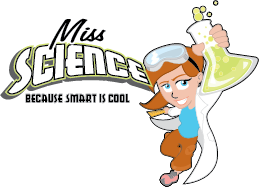Once seen as a place reserved for the school “Geeks,” STEM clubs and Makerspaces are now drawing a variety of students. In 2009, I started my first STEM Club at a local K-8 school and within a few years I had multiple summer camps running, hosting monthly segments on our NBC station, offering weekend workshops at the Microsoft Store, and participating on committees focused around STEM and workforce development.
My tagline for Miss Science became “Because Smart is Cool,” and my primary focus in all of this was to support STEM education and make it as relevant as possible for students, teachers and parents.
As a student I felt that science was in a vacuum that just never seemed to suck me in. It wasn’t until I started teaching that I became excited about science and began to understand the connections of science to everyday life.
Making real-world connections with STEM subjects became my mission. I love it when I see that “aha” moment in a student’s eyes or find out that a former student is now employed in a STEM career. Heck, my daughter has become a Miss Science in her own right as she enters her senior year at the University of Florida, earning a degree in Microbiology. Go Gators!
Although as a parent and educator these are great accomplishments, what about the other students who were in my class or attended my camps? What about my son who is earning a degree in accounting? If they don’t choose a STEM-based career are they going to be less successful?
While America struggles with a skills gap, we can’t assume that with a greater interest in STEM all students will be driven toward STEM careers. In fact, a survey conducted by Junior Achievement showed that there has been a significant drop in the number of students wanting to pursue careers in STEM. So, what do students want?
It is no surprise that students are craving an environment that goes beyond lecture, allows for creativity and offers more responsibility through involvement. What I find a bit shocking is that students are asking for more counseling.
Students, especially those in schools that continue to function on limited resources and funding, find themselves at a greater disadvantage. With ambitions of becoming a doctor, engineer or scientist, many high school students lack the skills to navigate the world of college applications and entry requirements.
Beyond those challenges, how many of these students have ever met with, talked to or shadowed people employed in STEM based careers? In addressing what students want, we should be offering opportunities that go beyond school walls through STEM clubs and Makerspace.
Future Ready framework tells us that not only should we provide curriculum and instruction that supports personalized learning, but we also need to create community partnerships. It is through those partnerships that students can gain a better understanding of career choice.
Getting involved in something like Citizen Science could be a great connection for schools, their community and career exploration. Students can curate resources around what they learn from these scientists or STEM professionals with what interests them to gain a greater understanding of what is expected in that field. This brings relevancy to what they see as a STEM career choice. Using concepts like a Makerspace to go beyond skills such as programming and coding with activities like circuits or soldering can support learning more about skilled trade occupations.
It’s strange to me that we rarely promote these jobs, yet I can’t seem to find anyone who is available to work on adding additional outlets to my house. If architecture is now considered a STEM subject, why isn’t construction? I sure hope that the electrician I hire (when I find her) understands how electrical circuits work.
I’m a big fan of Mike Rowe and his quest for filling the trade-skills gap within our workforce. This interview with Dr. Barbara Jenkins, Superintendent of OCPS in Orlando, Florida, speaks volumes about transitioning our ideas of what once was called vocational education or “Vo-tech” to understanding the importance of Career and Technical Education.
It is my hope that through STEM Clubs and Makerspace we can promote STEM within all careers. We can demystify careers that require hard STEM skills while eliminating the stigma that surrounds those that don’t.
Let’s take a closer look at how STEM relates to the world we live in and help students become better problem seekers and problem solvers no matter what career path they choose. It is our goal to make sure that every student becomes an employable part of the American workforce. As educators we don’t just want to fill gaps, we want to change lives.
Posted on Follett Community: https://www.follettcommunity.com/s/article/stem-education-needs-to-go-beyond-the-employment-gap
